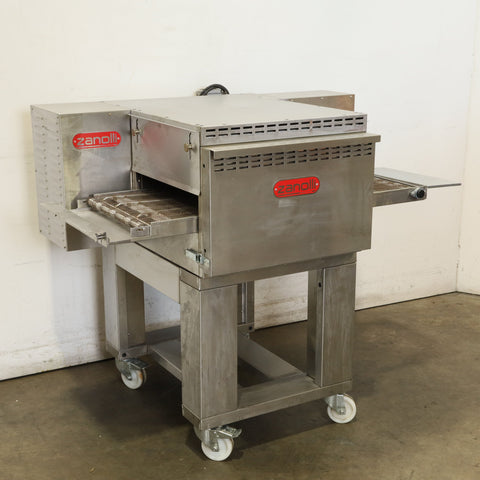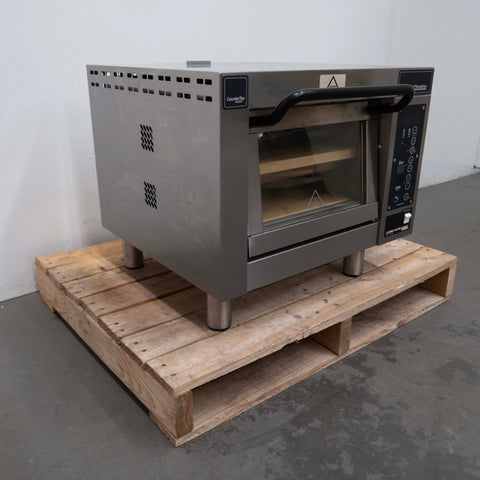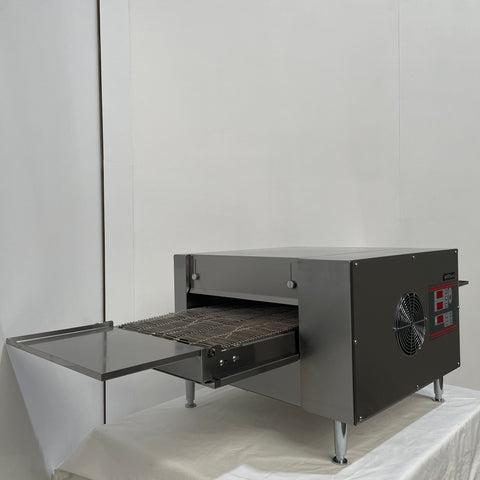
Recently Viewed

 BakerMax Pizza Conveyor Oven HX-1E
BakerMax Pizza Conveyor Oven HX-1E
1510(W) x 580(D) x 430(H)mm


 BakerMax Black Panther Pizza Deck Oven EP-1-SDE
BakerMax Black Panther Pizza Deck Oven EP-1-SDE
1190(W) x 826(D) x 775(H)mm

 Anvil Conveyor Pizza 3PH 400V - POK0004
Anvil Conveyor Pizza 3PH 400V - POK0004
1499(W) x 426(H) x 575(D)mm

 Anvil Conveyor Pizza 1 PH 240V - POK0003
Anvil Conveyor Pizza 1 PH 240V - POK0003
1499(W) x 426(H) x 575(D)mm


 BakerMax Prisma Food Pizza Ovens Double Deck 12 X 35Cm TP-2-SD
BakerMax Prisma Food Pizza Ovens Double Deck 12 X 35Cm TP-2-SD
1100(W) x 1320(D) x 745(H)mm


 BakerMax Prisma Food Pizza Ovens Double Deck 8 X 40Cm TP-2
BakerMax Prisma Food Pizza Ovens Double Deck 8 X 40Cm TP-2
1100(W) x 1080(D) x 745(H)mm


 BakerMax Black Panther Pizza Deck Oven EP-2-1E
BakerMax Black Panther Pizza Deck Oven EP-2-1E
890(W) x 846(D) x 455(H)mm

 BakerMax Pizza Conveyor Oven With 3 Phase Power HX-1/3NE
BakerMax Pizza Conveyor Oven With 3 Phase Power HX-1/3NE
1510(W) x 580(D) x 430(H)mm


 BakerMax Black Panther Pizza Deck Oven EP-2E
BakerMax Black Panther Pizza Deck Oven EP-2E
890(W) x 846(D) x 775(H)mm

 BakerMax Pizza Conveyor Oven HX-2E
BakerMax Pizza Conveyor Oven HX-2E
2140(W) x 748(D) x 332(H)mm


 BakerMax Black Panther Pizza Deck Oven EP-1-1-SDE
BakerMax Black Panther Pizza Deck Oven EP-1-1-SDE
1190(W) x 826(D) x 455(H)mm

 BakerMax Compact Countertop Double Deck Electric Pizza Oven EP-2T
BakerMax Compact Countertop Double Deck Electric Pizza Oven EP-2T
580(W) x 561(D) x 435(H)mm

 Anvil Pizza Oven - POA1001
Anvil Pizza Oven - POA1001
588(W) x 468(H) x 645(D)mm




 Apuro 406mm Firestone Pizza Oven - CJ373-A
Apuro 406mm Firestone Pizza Oven - CJ373-A
620(W) x 200(H) x 565(D)mm


1630W x 1140D x 1110Hmm


1170W x 1010D x 1055Hmm


 Anvil POK0004 Conveyor Pizza Oven - 761779
Anvil POK0004 Conveyor Pizza Oven - 761779
1499W x 575D x 436Hmm


 Woodson W.CVP.C.24 Conveyor Oven - 869272
Woodson W.CVP.C.24 Conveyor Oven - 869272
1500W x 765D x 420Hmm


600W x 610D x 400Hmm


600W x 610D x 400Hmm


1350W x 1260D x 1855Hmm


 2NDs: Prisma Food SIngle Deck Gas Pizza&Bakery Ovens - PMG-9-NSW2080
2NDs: Prisma Food SIngle Deck Gas Pizza&Bakery Ovens - PMG-9-NSW2080
560(W) x 1362(D) x 1225(H)mm





1425W x 1100D x 1150Hmm


1265W x 790D x 440Hmm


 Woodson W.CVP.C.24 Conveyor Oven - 832078
Woodson W.CVP.C.24 Conveyor Oven - 832078
1500W x 780D x 440Hmm


 Prisma Food Solutions TP-2-SD Pizza Oven - 848747
Prisma Food Solutions TP-2-SD Pizza Oven - 848747
1100W x 1300D x 1650Hmm


1265W x 790D x 440Hmm


1970W x 1450D x 1220Hmm


 Moretti Forni iDeck PD105.65 Pizza Oven + Stand - 874721
Moretti Forni iDeck PD105.65 Pizza Oven + Stand - 874721
1320W x 1080D x 1670Hmm

 2NDs: Prisma Food Pizza Ovens Double Deck 12 x 35cm - TP-2-SD-SA6-Aug
2NDs: Prisma Food Pizza Ovens Double Deck 12 x 35cm - TP-2-SD-SA6-Aug
745(W) x 1320(D) x 1180(H)mm


 Moretti Forni AMACB18I 2 Deck Pizza Oven with Stand - 851541
Moretti Forni AMACB18I 2 Deck Pizza Oven with Stand - 851541
1320W x 1330D x 1860Hmm


1170W x 1010D x 1055Hmm


1980W x 1330D x 1750Hmm


 Anvil POK0004 Conveyor Pizza Oven - 896651
Anvil POK0004 Conveyor Pizza Oven - 896651
1530W x 430D x 575Hmm
1530W x 575D x 430Hmm


 Prisma Food TP-2 Double Deck Pizza Oven + Stand - 818825
Prisma Food TP-2 Double Deck Pizza Oven + Stand - 818825
1110W x 1080D x 1610Hmm
1110W x 1610D x 1080Hmm


 Federal HX-1/3NE Conveyor Oven - 886412
Federal HX-1/3NE Conveyor Oven - 886412
1510W x 430D x 570Hmm
1510W x 570D x 430Hmm


 Moretti Forni PD 105.105 Deck Pizza Oven + Stand - 778660
Moretti Forni PD 105.105 Deck Pizza Oven + Stand - 778660
1330W x 1460D x 1700Hmm
1330W x 1700D x 1460Hmm


1490W x 1300D x 2180Hmm
1490W x 2180D x 1300Hmm


662W x 366D x 513Hmm
662W x 513D x 366Hmm


1480W x 1825D x 905Hmm
1480W x 905D x 1825Hmm


 XLT 2440 H Conveyor Oven - 809586
XLT 2440 H Conveyor Oven - 809586
1980W x 1090D x 1350Hmm
1980W x 1350D x 1090Hmm


1860W x 1000D x 980Hmm
1860W x 980D x 1000Hmm


1270W x 440D x 800Hmm
1270W x 800D x 440Hmm


 PrismaFood TP-2 Pizza Oven - 759448
PrismaFood TP-2 Pizza Oven - 759448
1100W x 1095D x 745Hmm
1100W x 745D x 1095Hmm


1160W x 410D x 710Hmm
1160W x 710D x 410Hmm


 2NDs: Baker Max Pizza Conveyor Oven HX-2E-NSW1793
2NDs: Baker Max Pizza Conveyor Oven HX-2E-NSW1793


 Anvil POK0003 Conveyor Oven - 825288
Anvil POK0003 Conveyor Oven - 825288
1499W x 436D x 575Hmm


860W x 395D x 900Hmm
860W x 900D x 395Hmm
Commercial deck ovens are a popular appliance found in many Australian commercial kitchens. These ovens are specifically designed for high volume baking, making them ideal for restaurants, bakeries, and foodservice establishments. These ovens are not only for pizza, but also help make a perfect flaky crust on any type of pastry and bread. One key feature of commercial deck ovens is their multiple decks or shelves, which allow for efficient baking of various products simultaneously. This is particularly useful for businesses looking to increase productivity and output. Australia business owners benefit from the versatility of deck ovens, which can be used to bake a wide range of products such as bread, pastries, pizzas, and more. The even heat distribution in a deck oven ensures consistent and high-quality results with each use. Moreover, deck ovens are known for their durability and energy efficiency, providing excellent value for money over the long term. This makes them a wise investment for businesses looking to streamline their baking operations while maintaining high standards of quality. A deck oven is a type of commercial oven that features multiple deck levels, usually made of stone or ceramic. Each deck functions as a separate baking surface, allowing for multiple products to be baked at the same time. Deck ovens are often used in professional kitchens for baking bread, pizzas, and other baked goods due to their ability to produce even heat distribution and consistent results. A rack oven and a deck oven are two types of ovens commonly used in commercial kitchens, each with its own set of features. A deck oven is a versatile piece of equipment commonly used in bakeries and pizzerias to bake a variety of products. Items that can be baked in a deck oven include but are not limited to: Deck ovens typically do not require a hood, as they are usually designed to be ventless and do not produce excessive amounts of smoke or steam. However, it is important to check with local regulations and building codes to ensure compliance with ventilation requirements in your specific area. If unsure, we recommend consulting with a qualified professional to determine the appropriate ventilation setup for your deck oven. Deck ovens offer several benefits for commercial kitchens: The temperature at which you bake in a deck oven typically ranges from 400°F to 600°F, depending on the type of item you are baking and the desired outcome. It is important to refer to the specific recipe or baking instructions for more precise temperature guidance. Yes, you can cook pizza in a deck oven. Deck ovens are commonly used in pizzerias and restaurants to bake pizzas. They consist of one or multiple separate baking chambers, known as decks, which provide even heat distribution, making them ideal for baking pizzas. Deck ovens are designed to reach high temperatures necessary for creating crispy pizza crusts while ensuring the toppings are thoroughly cooked. Overall, deck ovens are a popular choice for baking pizzas to perfection. Both electric and gas deck ovens have their own set of advantages and disadvantages. Deck ovens typically do not have built-in steam functionality. They are primarily used for baking and cooking without the use of steam. However, some models may have a separate steam injection accessory that can be added for certain baking applications. Certainly! The main difference between a wood-fired oven and a deck oven lies in the way they generate heat to cook food. The maximum temperature for a deck oven can vary depending on the specific make and model. In general, most deck ovens have a maximum temperature range of 500 to 700 degrees Fahrenheit. It is recommended to refer to the manufacturer's specifications for the exact maximum temperature for a specific deck oven model. A deck oven is typically made of stainless steel, which is known for its durability and heat resistance. The interior of the oven features stone or ceramic baking decks that help to distribute heat evenly for consistent baking results. A double deck oven is a type of commercial oven that consists of two separate oven chambers stacked on top of each other. This design allows for increased cooking capacity without taking up additional floor space in the kitchen. It is commonly used in restaurants and bakeries to simultaneously bake different dishes or batches of food at varying temperatures. To clean a deck oven, start by allowing the oven to cool down completely. Remove any trays, racks, or other accessories from the oven. Use a damp cloth or sponge to wipe down the interior surfaces, including the walls, ceiling, and floor. These are the top 10 FAQs for Deck Ovens in 2026
What is a deck oven?
What is the difference between a rack oven and a deck oven?
A rack oven is designed to bake large quantities of food quickly and efficiently. It is equipped with racks that can be rolled in and out, making it easy to load and unload multiple trays of food at once. Rack ovens are ideal for high volume baking operations and are often used in bakeries, pizzerias, and other food service establishments.
On the other hand, a deck oven is a more traditional type of oven that features one or more cooking chambers, or "decks," where food is placed directly on the oven floor. Deck ovens are known for producing a crispy crust and even baking, making them popular choices for baking bread, pizzas, and other baked goods.
In summary, the main difference between a rack oven and a deck oven lies in their design and functionality. Rack ovens are designed for high volume baking with easy loading and unloading of multiple trays, while deck ovens provide excellent heat distribution and are well-suited for traditional baking methods.
What can be baked in a deck oven?
- Bread
- Baguettes
- Pizza
- Pastries
- Cookies
- Croissants
- Buns
- Pretzels
Deck ovens are known for providing even heat distribution and the ability to achieve crispy crusts and delicious browning, making them suitable for a wide range of baked goods.
Do deck ovens require a hood?
What are the benefits of a deck oven?
1. Versatility: Deck ovens are highly versatile and can be used for a variety of cooking tasks including baking bread, pizzas, cookies, and more. They are suitable for businesses that offer a wide range of baked goods.
2. Consistent Heat Distribution: Deck ovens typically have even heat distribution across the cooking surface, ensuring that food is cooked evenly and consistently.
3. Capacity: Deck ovens often have multiple decks or shelves, allowing for greater cooking capacity compared to other types of ovens. This can be particularly useful for busy restaurants or bakeries.
4. Durability: Commercial-grade deck ovens are built to withstand the demands of a busy kitchen and are designed to be durable and long-lasting.
5. Traditional Baking Results: Deck ovens replicate the classic baking techniques used in traditional brick ovens, resulting in a unique and authentic flavor profile for baked goods.
Overall, the benefits of a deck oven include versatility, consistent heat distribution, increased capacity, durability, and the ability to achieve traditional baking results.
What temperature do you bake in a deck oven?
Can you cook pizza in a deck oven?
Which is better electric or gas deck oven?
Electric deck ovens are known for their even and consistent heat distribution, making them ideal for baking products that require precise temperature control. They are also easier to install and maintain compared to gas deck ovens.
On the other hand, gas deck ovens heat up more quickly and are generally more cost-effective to operate in the long run. They are also preferred by some chefs for their ability to provide a higher level of moisture, which can result in better crust development in certain baked goods.
Ultimately, the choice between electric and gas deck ovens will depend on your specific needs, preferences, and budget. We recommend considering factors such as the type of products you will be baking, your available utility connections, and your overall kitchen setup before making a decision.
Do deck ovens have steam?
What is the difference between wood fired and deck oven?
A wood-fired oven uses wood as its primary fuel source, and the heat is produced by burning the wood directly in the oven chamber. This method imparts a distinct smoky flavor to the food and is often preferred for traditional cooking methods.
On the other hand, a deck oven is a type of commercial oven that is designed with multiple stacked baking decks. These decks are heated using electric or gas elements, providing consistent and even heat distribution for baking a variety of items such as bread, pizza, and pastries.
Ultimately, the choice between a wood-fired oven and a deck oven depends on the specific cooking needs of the restaurant and the desired flavor profile of the dishes being prepared.
What is the maximum temperature for a deck oven?
What is deck oven made of?
What is a double deck oven?
How do you clean a deck oven?
For tougher grease and grime, use a non-abrasive oven cleaner specifically designed for commercial ovens. Follow the manufacturer's instructions carefully and make sure to wear gloves and work in a well-ventilated area.
For the oven door, use a glass cleaner to clean both the inside and outside of the glass. Make sure to dry it thoroughly to prevent streaks.
Do not forget to clean the oven's exterior as well, using a mild detergent and water to wipe down the surfaces.
Regular cleaning and maintenance of your deck oven will help prolong its lifespan and ensure optimal performance. If you have any specific questions or concerns about cleaning your deck oven, feel free to contact our customer support team for more detailed assistance.